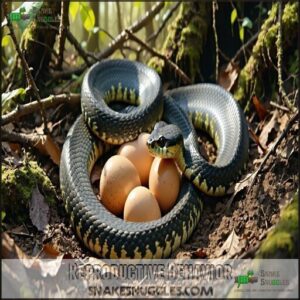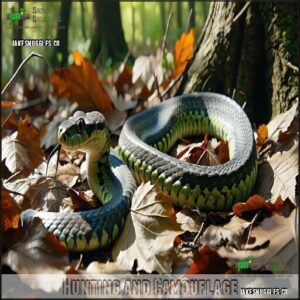This site is supported by our readers. We may earn a commission, at no cost to you, if you purchase through links.

They don’t have teeth, but flexible jaws let them swallow eggs whole. Inside their throat, bony spikes crack the shells, and they later regurgitate the empty shells.
These snakes are nonvenomous and rely on a keen sense of smell to locate bird nests.
Found in Africa and parts of Asia, they prefer warm, forested areas. Their small size, usually under 3 feet, helps them stay hidden. With smooth scales and muted colors, they blend into their habitat.
Curious how their digestion works? It’s one of their coolest traits!
Table Of Contents
- Key Takeaways
- Physical Characteristics and Adaptations
- Habitat and Behavior
- Diet and Feeding
- Appearance & Colors
- Lifespan and Average Size
- Egg-Eating Snake Care
- Unique Physiology and Adaptations
- Reproductive Behavior
- Hunting and Camouflage
- Other Facts
- Frequently Asked Questions (FAQs)
- What are some interesting facts about egg-eating snakes?
- How long do egg-eating snakes get?
- Where do egg-eating snakes live?
- Are egg-eating snakes aggressive?
- What does an egg-eating snake consume?
- Are egg eating snakes venomous?
- What is an egg-eating snake?
- What does an egg eating snake look like?
- Why do snakes eat bird eggs?
- Are egg-eating snakes active during the day?
- Conclusion
Key Takeaways
- You’ll find egg-eating snakes rely on their flexible jaws and bony throat spikes to swallow bird eggs whole, crush the shells, and regurgitate them after digesting the contents.
- They’re nonvenomous, toothless, and depend on a sharp sense of smell and camouflage to locate nests and stay hidden from predators.
- These snakes live in warm, forested areas in Africa and parts of Asia, adapting to nocturnal hunting and seasonal changes in egg availability.
- Egg-eating snakes play an important role in balancing ecosystems by regulating bird populations through nest predation.
Physical Characteristics and Adaptations
You’ll notice egg-eating snakes have fascinating physical traits that make their diet possible.
Their flexible jaws, lack of teeth, and specialized bony structures help them swallow and crush eggs with ease.
Flexible jaws, toothless mouths, and bony crushers make egg-eating snakes unstoppable specialists in swallowing and crushing eggs.
Flexible Jaw Muscles
Flexibility is key regarding egg-eating snakes, and their jaws redefine adaptability.
Their flexible jaws aren’t just unique—they’re perfectly crafted for swallowing large eggs up to three times the size of their head. This jaw muscle strength, combined with cranial kinesis, makes them masters of their diet.
Here’s how it works:
- Elastic ligaments connect their jaw joints, enabling wide stretches.
- Quadrate bones rotate outward to allow greater expansion.
- Specialized jaw muscles work together for extreme stretching without strain.
- Multiple skull articulations stabilize the process.
- The left and right mandibles move independently, ensuring no dislocation.
These features let them smoothly swallow eggs while preventing harm to their toothless mouths and delicately expanding esophagus.
Lack of Teeth
For egg-eating snakes, their toothless mouths are a game-changer.
This unique adaptation isn’t a limitation—it’s an evolutionary advantage.
Toothless snakes, like those in the Dasypeltis genus, use specialized jaw ridges to handle eggs smoothly, maximizing efficiency.
Their calm temperament makes them ideal pets for enthusiasts.
Here’s how their toothless adaptation works to their benefit:
- Mouth Capacity: Toothless mouths allow them to swallow large eggs effortlessly.
- Smooth Passage: Eggs move internally without breaking prematurely, ensuring safe digestion.
- Egg Handling: Flexible jaws focus entirely on swallowing and crushing eggs, not gripping.
This clever design is critical to their survival as specialized feeders.
Bony Protrusions
You’re probably wondering how an egg-eating snake handles its unique diet without teeth.
Nature stepped in with a genius fix—bony protrusions, also called vertebral hypapophyses.
These specialized esophageal spines, extending from the backbone, crush eggshells effortlessly.
The snake swallows an egg whole, and the spines break it open, keeping the yolk and white intact.
This evolutionary advantage allows the snake to digest the contents while regurgitating the empty shells later.
Remarkable snake anatomy, right?
Regurgitation of Egg Shells
Once the snake’s bony protrusions crush the egg, the next step is equally fascinating. Their specialized digestive system extracts every bit of nutrition from the contents, leaving only the empty shell behind.
To protect their insides, the snakes rely on their efficient eggshell regurgitation system to eliminate sharp fragments.
Here’s how it works:
- The esophageal mechanics compress the eggshell into a small, harmless lump.
- Their nutrient absorption process focuses solely on the yolk and egg white.
- Regurgitation typically happens 30–60 minutes after eating.
- They expel the compressed shell through their mouth rather than the digestive tract.
- This waste elimination method prevents injury to delicate internal organs.
This unique process makes certain the snake benefits from the egg’s nutrients while staying safe, showing just how well-adapted their biology is.
Smelling With Tongues
To locate fresh eggs, egg-eating snakes rely on their highly specialized tongue and sensory abilities. They don’t taste with their tongue—they smell with it, thanks to Jacobson’s organ.
Through scent molecule detection, their forked tongue gathers chemical signals from the air, translating them into precise olfactory cues. This allows an egg-eating snake to locate nests with incredible accuracy.
Here’s how it works:
- The snake flicks its tongue out to capture scent molecules.
- Molecules are delivered to Jacobson’s organ for processing.
- The organ decodes the scent, guiding the snake to fresh eggs.
Habitat and Behavior
You’ll find egg-eating snakes in a variety of habitats, from forests to savannas, where they stay hidden during the day.
They’re nocturnal hunters, relying on camouflage and quiet movement to find bird nests and avoid predators.
Nocturnal Behavior
Gliding through moonlit branches, egg-eating snakes thrive on nighttime activity.
Their nocturnal behavior, perfected for stealth, allows them to locate prey in the shadows.
Specialized night vision aids their sensory adaptations, making predator avoidance effortless as they navigate silently.
These snakes adjust their sleep patterns to hunt when predators are least active.
Climatic influence shapes their movements, ensuring survival in diverse environments.
Darkness becomes their ally, turning egg-eating behavior into an art of precision.
Avoidance of Humans
Unlike many reptiles, egg-eating snakes prefer evasion over confrontation regarding human interaction.
They rely on stealth and avoidance, silently slipping away rather than confronting potential threats or predators.
These snakes rely heavily on predator avoidance and non-aggressive behaviors to guarantee their safety.
They use evasion tactics like staying motionless, blending with their environment through cryptic coloration that mimics tree bark or leaf litter.
When they sense danger, they silently slip into:
- Dense vegetation or hollow logs where they’re nearly invisible
- Abandoned burrows, offering secure hiding spots
- Foliage cover that muffles their movements
These snake defense mechanisms allow them to avoid detection without aggression.
Such defensive behaviors make them fascinating creatures, even within the exotic pet trade, where stress-free handling is key to their well-being.
Thermal Regulation
Thermoregulation is key to how egg-eating snakes thrive in diverse habitats.
These cold-blooded reptiles adjust body temperature by moving through thermal gradients.
They bask in warm spots, soaking up temperatures between 85-90°F to fuel high activity levels. During nocturnal activity, they prefer cooler zones around 75-82°F, while resting happens in even cooler environments, as low as 60°F.
This mastery of basking behavior helps them survive environmental changes efficiently.
In captivity, mimicking these preferred zones is fundamental. Provide basking lamps and heating pads, enabling snakes to find their thermal sweet spot.
Their ability to balance temperatures makes certain they stay active when needed and conserve energy during quieter periods.
Nest Hunting
Egg-eating snakes are masters of nest hunting, relying on sharp senses and unwavering stealth tactics.
They use their forked tongues and Jacobson’s organ to precisely detect fresh bird eggs, often from several feet away.
With excellent climbing skills, they navigate trees and squeeze into tight spots where nests are hidden.
Operating mainly at night, these experts of nocturnal hunting carefully time their approach to avoid detection by parent birds.
- Egg Detection: Senses freshness with their specialized organs.
- Climbing Skills: Agile enough to scale the highest branches.
- Stealth Tactics: Wait for nests to be unguarded.
- Tongue Use: Finds eggs using tongue-flicking precision.
Diet and Feeding
Egg-eating snakes survive on a diet of eggs, mostly from birds. They swallow the eggs whole, crush the shells using specialized bones, and regurgitate the remains after consuming the contents.
Exclusive Consumption of Bird Eggs
Some snakes eat a variety of prey, but the egg-eating snake’s focus is laser-sharp: bird eggs.
This dietary specialization allows them to consume eggs up to three times their head size.
They test egg freshness with their tongue, crush shells using specialized internal bones, and regurgitate the shell after absorbing nutrients.
During bird breeding seasons, they feast on accessible eggs, but their egg-only diet means they rely on seasonal fasting when eggs are scarce.
| Trait | Adaptation | Function |
|---|---|---|
| Egg Freshness | Tongue detection | Guarantees egg safety for digestion |
| Egg Size | Flexible jaws | Consumes eggs much larger than head |
| Crushing Mechanism | Esophageal bones | Breaks shells internally |
| Seasonal Fasting | Fat reserves | Survives during non-breeding seasons |
| Dietary Specialization | Exclusive egg-only diet | Matches food niche with avian impact |
Adaptable Diet
Egg-eating snakes show amazing adaptability with their egg-only diet, adjusting to seasonal changes and egg availability.
Their specialized jaws and digestive systems handle eggs of different sizes, prioritizing nutritional intake.
These snakes even sniff out egg freshness before eating, ensuring a safe meal.
Here’s what makes their diet so extraordinary:
- They consume eggs up to three times their head size.
- Seasonal fasting allows them to thrive between bird breeding periods.
- Dietary restrictions mean only fresh bird eggs meet their needs.
- They expertly select egg sizes based on their own body and nutritional needs.
Nest Bird Predation
In the context of nest bird predation, these snakes are experts at finding bird nests to feed on eggs. Their forked tongues pick up chemical signals, allowing them to locate fresh eggs with impressive accuracy. This highly specific skill peaks during breeding seasons when eggs are most abundant.
They consume 2-3 eggs per visit, impacting bird populations in noticeable ways. Their feeding habits influence where birds build nests and how they defend them.
- Use chemical cues to locate nests from a distance.
- Seasonal predation affects avian defenses.
- Directly impacts nest success rates by reducing egg survival.
- Plays an important role in balancing bird populations and ecosystems overall.
Appearance & Colors
You’ll notice egg-eating snakes have long, slender bodies covered in smooth scales that can range from reddish-brown to gray.
Their angular patterns provide excellent camouflage, helping them blend seamlessly into their environment.
Description of Scales and Head
The egg-eating snake’s head shape is compact and rounded, blending seamlessly into its slender body.
Its keeled scales provide a coarse texture, ensuring both protection and ease of movement. These scales also vary slightly across individuals, adding to their unique charm.
Prominent sensory pits near their expressive eyes enhance their ability to detect prey.
The head’s smooth structure lets it maneuver into tight spaces, perfect for egg collection.
As a pet owner, you should watch for scale rot, which can damage the scale texture and overall health. Healthy scales highlight their intricate snake patterns and functional design.
Coloration and Patterns
Scale variations in egg-eating snakes showcase amazing regional coloration and pattern camouflage.
Their hues range from grayish-brown to reddish with angular snake patterns that blend into their surroundings.
You’ll notice two standout features:
- Color Morphs – Created by light and dark contrasts, helping them adapt to specific habitats.
- Pattern Types – Zigzags, subtle striping, or bands offer juvenile markings that change with age.
These adaptive colorations make hiding in plain sight their ultimate skill.
Gender Differences
Female egg-eating snakes stand out due to their size, often reaching 3-4 feet compared to males, who max out at 2 feet.
This sexual dimorphism ties to reproduction roles—females need space for eggs, while males focus on agility.
Females consume larger eggs, supporting their nutritional needs.
Here’s a quick comparison:
| Trait | Female | Male |
|---|---|---|
| Size | 3–4 feet | 18–24 inches |
| Clutch Size | Up to 30 eggs | N/A |
| Lifespan (Captive) | 10–15 years | Slightly shorter |
Lifespan and Average Size
Egg-eating snakes typically live up to 7 years in the wild but can reach 10 to 15 years in captivity with proper care.
They range from 30 to 100 cm in length, with females generally larger than males.
Lifespan in The Wild
In the wild, the snake lifespan of egg-eaters averages around 7 years, shaped by food availability, habitat quality, and predator impact.
Factors like seasonal challenges, disease susceptibility, and environmental threats influence mortality rates.
Adaptable snakes, aligning with local bird nesting cycles, often outlive others.
Predator encounters and harsh climates add unique age factors, limiting their lifespan in the wild.
These snakes thrive where habitat impact is minimal and resources plentiful, showing incredible resilience.
Each year they survive demonstrates nature’s balance—highlighting their ability to navigate dangers while relying on their specialized diet and elusive nature to endure harsh environmental conditions.
Size and Sexual Dimorphism
Size and sexual dimorphism are key traits of egg-eating snakes, with noticeable differences in male size and female size.
On average, females grow substantially larger, reaching an average length of 1020mm, compared to the smaller males at 697mm. These size differences directly affect their eating and reproduction.
- Female Size: Females develop longer, wider heads, ideal for swallowing larger eggs, often up to 24mm in diameter.
- Male Size: Males have thicker, longer tails to house their hemipenes, while females have shorter, thinner tails.
- Weight Variations: Females tend to be heavier in response to egg production needs, further influencing growth.
In captivity, growth reflects environmental factors like diet and care, showcasing how snake size adapts for survival and reproduction.
Egg-Eating Snake Care
Caring for an egg-eating snake requires a well-prepared enclosure that mimics its natural habitat.
You’ll need to maintain proper temperatures, humidity levels, and provide a diet of fresh bird eggs to keep it healthy.
Enclosure Size and Setup
Designing the right enclosure size for your egg-eating snake means starting with at least a 20-gallon tank, prioritizing width over height.
Aim for dimensions like 24"W x 18"D x 12"H.
The habitat setup should mimic their natural environment, focusing on ground-level movement, with climbing branches and 2-3 hiding spots for security.
Use a soft substrate type like aspen shavings or bark, layering it about an inch deep to encourage burrowing behavior.
Add plants and vines to make the space feel natural.
A good layout balances open areas and covered spaces, helping your snake feel safe.
Consider appropriate tank products for your snake’s habitat.
This low-profile tank offers room to explore and settle comfortably while supporting natural habits.
Temperature, Humidity, and Water
Proper temperature, humidity, and water management are key for your egg-eating snake’s health.
Here’s how to create the perfect environment:
- Optimal Temperature: Maintain a gradient from 70-90°F. Use a heat lamp or pad to create a basking spot, allowing natural temperature regulation.
- Humidity Levels: Keep humidity at 40-60%. Mist regularly and use shedding humidity techniques, like adding damp moss, to help during shedding.
- Water Source: Provide fresh water daily in a sturdy, shallow dish that won’t tip. This secures proper hydration.
Consistency is key. Some owners use specialized products to secure consistent snake heat.
Your snake will instinctively move between warm or cool areas to balance its body temperature, securing comfort in its “climate-controlled” space.
Specialized Diet
Egg-eating snakes have a fascinating egg-only diet designed entirely around bird eggs.
Their unique egg-eating behavior hinges on their ability to swallow eggs whole and extract every bit of nutrition.
Egg size plays a key role—you’ll need smaller eggs, like finch eggs, for younger snakes and quail eggs for larger ones.
These snakes can’t handle rotten eggs, so checking egg freshness is critical.
After the feast, shell regurgitation occurs, leaving just the empty shell behind.
With dietary restrictions like avoiding other reptile eggs, they rely on seasonal fasting outside bird nesting periods.
Their specialized reptile diet reflects impressive adaptations made for life on eggs.
Understanding appropriate egg dimensions is paramount.
Unique Physiology and Adaptations
You’ll find egg-eating snakes have evolved remarkable physical traits to master their unique diet.
From rear-facing teeth to highly flexible jaw joints and specialized belly scales, each adaptation guarantees they efficiently consume and process eggs. Complete concepts and double new lines have been used to separate the text.
Rear-facing Teeth
Behind their toothless appearance, egg eating snakes boast rear-facing teeth, showcasing fascinating tooth adaptation for an egg-only diet.
Though technically toothlike structures, these small, backward-angled projections play a central role in feeding efficiency.
- Egg piercing is powered by these esophageal teeth, guaranteeing eggs stay in place during crushing.
- Their unique tooth morphology includes spikes coated for durability, handling repeated use.
- Evolutionary purpose is clear—these adaptations secure and pierce eggs effortlessly, making this snake specialized for its singular feeding method.
Jaw Joint Flexibility
Egg-eating snakes’ jaw joint flexibility is truly remarkable!
Their flexible jaws, supported by elastic ligaments and specialized jaw biomechanics, stretch wide enough to handle eggs up to three times their head size.
This unhinging-like skull movement allows for efficient egg consumption without teeth and showcases an evolutionary advantage for handling large prey.
Snakes achieve this flexibility through independent quadrate bone movement.
| Feature | Function | Benefit |
|---|---|---|
| Flexible jaws | Egg consumption | Adapts to varied egg sizes |
| Elastic ligaments | Wide jaw opening | Handling large prey easily |
| Toothless anatomy | Egg-shell safety | Smooth ingestion |
| Skull structure | Stability | Prevents injury when feeding |
| Feeding efficiency | Maximum energy gain | Fast swallowing mechanism |
Specialized Belly Scales
Specialized belly scales play a huge role in egg eating snake adaptations.
Their scale morphology is uniquely textured for friction reduction and locomotion aid, letting them climb trees with ease.
These overlapping scales grip surfaces like built-in cleats, a perfect climbing adaptation.
Besides movement, the scales enhance sensory function, helping them detect textures while hunting.
This snake adaptation blends form and function, allowing egg eaters to search nests, hunt effectively, and showcase natural mastery of their environment.
Reproductive Behavior
Egg-eating snakes lay eggs in small, hidden locations where the young are safe after hatching. Females use their larger size to store energy needed for producing healthy clutches.
Egg Production and Regurgitation
Female egg-eating snakes are masters of egg production and regurgitation, shaping their survival in unique ways.
Their clutch size varies, typically holding 6–25 eggs, depending on nutrition and egg size. Once eggs are consumed, they extract nutrients through yolk digestion while crushing shells with bony vertebral projections. Finally, they perform shell regurgitation, ejecting the leftover fragments.
- Females guarantee egg freshness by testing with their sensitive tongues.
- Shell regurgitation prevents digestive blockages and enhances feeding efficiency.
- Egg formation aligns with annual breeding cycles.
- Consuming diverse eggs supports female nutrition, needed for healthy reproduction.
Mimicry of Venomous Snakes
You’ll be amazed how egg-eating snakes use Batesian mimicry to outsmart predators.
Their scale patterns and snake coloration closely resemble venomous species, like the saw-scaled viper.
Add defensive mechanisms, like head triangulation and false striking, and their behavioral mimicry becomes convincing. This snake behavior lowers predator risk considerably.
Mimicry evolution has refined these traits over time, boosting predator avoidance.
These harmless snakes turn deception into survival, proving just how clever nature’s adaptations can be.
Slow Metabolism
After mimicking venomous snakes, egg-eating snakes showcase their remarkable slow metabolism, allowing them to thrive on rare meals. This adaptation ties directly to their unique energy needs and survival strategies.
- Their digestion process is fine-tuned for maximum efficiency, absorbing nearly 95% of nutrients from eggs.
- Fewer meals suit their low caloric intake requirements, often fasting for weeks.
- Controlled digestion rate secures steady energy over long fasting periods.
- Reduced energy expenditure keeps their activity levels manageable, especially during non-breeding seasons.
- Minimal thermoregulation impact saves energy in fluctuating environments.
This delicate balance of resource use showcases nature’s ingenuity, highlighting the egg-eating snake’s adaptability and frugal survival methods.
Hunting and Camouflage
You’ll find that egg-eating snakes rely on their keen sense of smell to locate bird nests and fresh eggs.
Their camouflage helps them blend into their surroundings, making it easier to stalk prey unnoticed.
Sense of Smell and Nest Detection
Egg-eating snakes rely on an incredible olfactory system to locate their meals.
Their forked tongue and Jacobson’s organ put scent tracking into overdrive, making them masters of nest location.
Using snake olfaction, they identify fresh eggs with precision.
Here’s what they do:
- Tongue flicking to gather airborne chemical signals.
- Process scents through the vomeronasal organ.
- Determine egg freshness by analyzing gradients.
- Observe bird activity for first-rate nest location.
- Navigate complex terrain using scent and environmental cues.
These adaptations guarantee precise nest detection every time.
Camouflage Adaptations
In the wild, egg-eating snakes excel at blending in with their surroundings through extraordinary camouflage strategies. Their scale patterns mimic tree bark, fallen leaves, and even shadows, aiding in nocturnal camouflage.
These snakes also utilize arboreal camouflage to remain hidden in trees, a must for hunting eggs. These patterns can be considered disruptive snake patterns to break up their outline.
Here’s a quick breakdown:
| Camouflage Type | Description | Key Benefit |
|---|---|---|
| Habitat Blending | Matches forest floors, bark | Avoid predators |
| Shadow Camouflage | Exploits light and dark areas | Enhances stealth |
| Color Patterns | Adapts to earthy natural tones | Silent egg hunting |
With these camouflage adaptations, they’re nearly invisible to predators and perfectly equipped for ambush.
Other Facts
You’ll find that egg-eating snakes have some remarkable traits beyond their hunting skills.
They play a key role in controlling bird populations and are classified as Least Concern in conservation.
Digestion of Eggshells
Egg-eating snakes have perfected eggshell digestion, making it an essential part of their survival.
Their Bony Crushers—esophageal protrusions—crack the shells after swallowing, ensuring smooth digestion. Once inside, enzymes work to dissolve the shell composition efficiently, turning it into a usable, calcium-rich meal.
The digestion process also includes Shell Regurgitation, where leftover fragments are expelled. This allows them to maximize nutrition while keeping their diet specialized.
- Digestive Efficiency: Enzymes process shells effectively.
- Calcium Benefits: Strengthens bones and supports health.
- Egg-Eating Snake Diet: Designed for maximum nourishment from delicate eggshells.
Conservation Status
According to the IUCN Red List, egg-eating snakes are classified as Least Concern.
However, they face threats like habitat loss due to agricultural expansion and collection for the pet trade.
While conservation efforts focus on habitat protection and population research, their future depends on addressing these risks.
Understanding egg-eating snake conservation guarantees strategies in reptile conservation contribute to their long-term survival.
Some island species face habitat loss challenges, impacting their survival.
Significance in Avian Population Control
Egg-eating snakes are skilled predators that shape ecosystems and maintain balance in bird populations. By preying on bird eggs, they influence avian biodiversity and nesting success, keeping certain species from overwhelming the food web.
Their role as nest predators leads birds to develop strategies, like better nest hiding, to increase their survival chances.
Their ecosystem impact includes:
- Regulating population dynamics by targeting specific bird eggs.
- Forcing birds to alter nesting habits or re-lay clutches.
- Promoting healthier bird diversity by managing nesting success and species spread.
These predators are nature’s way of ensuring balance within the food web.
Frequently Asked Questions (FAQs)
What are some interesting facts about egg-eating snakes?
Imagine swallowing a burrito three times your head’s size—that’s an egg-eating snake for you!
With no teeth, they crush eggs using spine bumps, regurgitate shells, and rely on smell to find fresh eggs.
How long do egg-eating snakes get?
These snakes grow between 30 to 100 cm (12 to 5 inches) long. Most fall within the 50 to 90 cm range, with females generally larger than males due to their higher energy needs for reproduction.
Where do egg-eating snakes live?
You’ll find egg-eating snakes in sub-Saharan Africa, Saudi Arabia, Yemen, and India.
They thrive in diverse habitats, from forests to grasslands, avoiding arid deserts and flooded areas.
Their adaptability helps them survive in various environments.
Are egg-eating snakes aggressive?
You might expect something dramatic, but no, egg-eating snakes aren’t aggressive.
They’d rather avoid you entirely.
Non-venomous and toothless, these snakes hiss or wriggle when threatened but prefer staying hidden over picking a fight. Non-venomous and toothless.
What does an egg-eating snake consume?
Egg-eating snakes eat bird eggs, relying on their flexible jaws to swallow them whole.
They crush the eggshells using bony throat structures, digest the contents, and regurgitate the shells.
Freshness is essential for their diet.
Are egg eating snakes venomous?
Imagine holding a harmless snake that hisses instead of biting.
Egg-eating snakes aren’t venomous.
They lack fangs altogether, relying on specialized bones in their throats to crush egg shells—perfectly adapted for their unique diet.
What is an egg-eating snake?
An egg-eating snake is a non-venomous reptile that survives solely on bird eggs.
Found mainly in Africa and India, it swallows eggs whole, crushes shells internally, and regurgitates them after digesting the contents.
What does an egg eating snake look like?
What does a snake built for devouring eggs look like?
Picture a slender body, soft brown-gray scales with dark patterns, a flexible snout, and a jaw that swallows eggs whole, nearly triple its head size!
Why do snakes eat bird eggs?
Bird eggs are a perfect food source for snakes.
They’re rich in nutrients and easy to digest.
Snakes evolved to find and swallow eggs whole, relying on their special jaw structure to do the job.
Are egg-eating snakes active during the day?
Under the moon’s watchful eye, egg-eating snakes thrive.
They’re mostly nocturnal, exploring trees and nests for eggs under night’s cloak.
During the day, they rest in cozy hideouts, avoiding harsh sunlight and disturbances. They’re mostly nocturnal.
Conclusion
These egg-eating snakes are fascinating examples of adaptation.
Their flexible jaws and throat bony spikes let them eat bird eggs with ease, a rare dietary niche.
Found in warm, forested areas across Africa and Asia, they rely on camouflage and sharp senses to survive.
Despite their lack of teeth and small size, these nonvenomous snakes thrive by blending into their habitat.
Understanding such unique reptiles showcases the incredible diversity of nature. What other animal adaptations amaze you?






















